Buddhist Relics Of
Swat Going Bamiyan Way
By M.M. Munshi
THE valley of
Swat
In
North West Frontier Province of Pakistan, once a centre of Buddhist culture, has
many ancient relics including 1,300 year old seated Buddha carved into a cliff
face above the town of Jahanabad.

The valley of
Swat, known for its isolation and scenic beauty, has been described as a
little paradise. The Buddhist called it Udyana, meaning a garden, and it
is because of its remoteness, behind the barrier of Malakand that Buddhism
survived here far longer than it did elsewhere in areas comprising today
Pakistan and Afghanistan, not giving an early
way to Islam. As a result many relics of Buddhist culture remain.
The most substantial of
these are found just over a kilometer from Saidu Sharif, the administrative
headquarters of Swat. The excavations carried out in late 1970s yielded a
rich collection of carvings, statues, decorated columns and jewellery. The
outlines of the central stupa and 200 smaller stupas surrounding it were clear
till a decade back.
In the upper part of the
valley Shringdar stupa also was in a better state of preservation. It is
believed by many that Chinese traveller Hieun Tsang visited this stupa also
during his travel in the subcontinent and mentioned that it was built by
Uttarasena, an ancient king of Swat, as a shrine for some relic of Buddah that
he had in his possession. But for the most imposing and beautiful monument
Buddhists have left in Swat is a carving of Buddha in sitting posture on a rock
cliff above the village of Jehanabad, about 16 kilometers from north of Saidu
Sharif.
The carving though
visible from the main road is approachable by a foot track which runs by the
side of an unexcavated stupa. It is also believed that Buddha himself visited
Swat and gave many sermons telling people the lessons he had learnt in earlier
lives.
 |
|
Before October 8, 2007 |
 |
|
Since October 8, 2007 |
Rock
carving of seated Buddhas at Swat in Pakistan.
The news that the head,
shoulders and feet of the carving have already been destroyed by fundamentalists
and they are planning to reduce it to rubble while the ruler of Pakistan is
looking to the other side. He is either unable to check this vandalism though he
did appeal to Mulla Omar to save the Buddha's statues of Bamiyan from
destruction or he is busy with other priorities. The face of the matchless
carving with a half smile and half closed eyes looking towards the setting sun
over a peaceful valley and green terraced hillsides, with its calm untroubled
gaze is probably lost for ever.
Source:
The Kashmir Times, Jammu, Sunday, December 2, 2007
| 